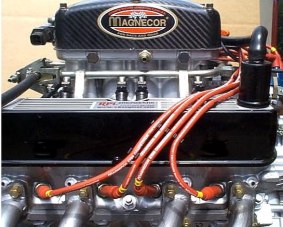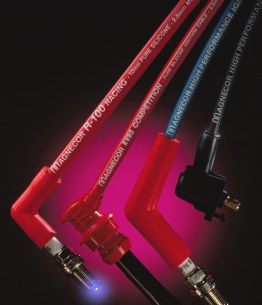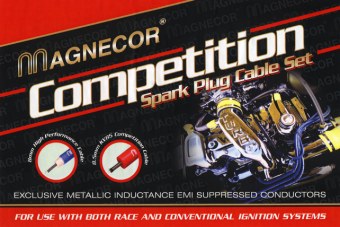'Low-resistance' conductors are an easy sell as most
people associate all ignition wire conductors with original
equipment, and replacement ignition wire carbon conductors
(which progressively fail as a result of microscopic carbon
granules burning away and thus reducing the spark energy to
the spark plugs) with solid wire zero-resistance conductors
that were used by racers with no need for suppression. Consumers
are easily led into believing that if a spiral conductor's
resistance is almost zero, its performance must be similar
to that of the solid metal conductor all race cars once used. HOWEVER, NOTHING IS FURTHER FROM THE TRUTH!
What is not generally understood (or is ignored) is, that
as a result of the laws of electricity, the potential 45,000
plus volts (with alternating current characteristics) from
the ignition coil (a pulse type transformer) does not flow
through the entire length of fine wire used for a spiral
conductor like the 1 volt DC voltage from a test ohmmeter,
but flows in a magnetic field surrounding the outermost
surface of the spiral windings (skin effect). The same skin
effect applies equally to the same pulsating flow of current
passing through carbon and solid metal conductors.
A spiral conductor with a low electrical resistance measured by an ohmmeter indicates, in reality, nothing other than less of the expensive fine wire is used for the conductor windings - a construction which cannot achieve a clean and efficient current flow through the magnetic field surrounding the windings, resulting in poor suppression for RFI and EMI.
Of course, ignition wire manufacturers save a considerable
amount in manufacturing costs by using less fine wire, less
exotic winding machinery and less expertise to make low-resistance
spiral conductors. As an incentive, they find a lucrative
market amongst performance parts marketers who advertise
their branded ignition wires as having 'low-resistance'
conductors, despite the fact that such 'low-resistance'
contributes nothing to make spiral ignition wires perform
better, and RFI and EMI suppression is compromised.
In recent years, most ignition wire manufacturers, to temporarily improve their spiral conductor's suppression, have resorted to coating excessively spaced spiral windings, most of which are crudely wound around strands of fiberglass or Kevlar, with a heavy layer of high-resistance carbon impregnated conductive latex or silicone compound. This type of construction hides the conductive coating's high resistance when the overall conductor is measured with a test ohmmeter, which only measures the lower resistance of the sparse spirally wound wire (the path of least resistance) under the conductive coating and ignores the high resistance of the outermost conductive coating in which the spark energy actually travels. The conductive coating is rarely shown or mentioned in advertisement illustrations.
The suppression achieved by this practice of coating the windings is only temporary, as the spark current is forced to travel through the outermost high-resistance conductive coating in the same manner the spark current travels through the outermost high-resistance conductive coating of a carbon conductor used in most original equipment and stock replacement wires.
In effect (when new), a coated 'low-resistance' spiral
conductor's true performance is identical to that of a high-resistance
carbon conductor.
Unfortunately, and particularly with the use of high-output
ignition, the outermost high-resistance conductive coating
over spiral windings acting as the conductor will fail from
burn out in the same manner as carbon conductors, and although
in most cases the spiral conductor will not cease to conduct
like a high-resistance carbon conductor, any RFI or EMI
suppression will be lost as a consequence of the coating
burning out. The worst interference will come from the so-called
'super conductors' that are wound with copper (alloy) wire.
However, despite the shortcomings of 'low-resistance' spiral
conductor ignition wires, these wires work satisfactorily
on older production vehicles and race vehicles that do not
rely on electronic engine management systems, or use on-board
electronics effected by EMI – although, with the lowest-resistance
conductor wires, don't expect much RFI suppression on the
AM band in poor reception areas.
Some European and Japanese original equipment and replacement
ignition wires, including Bougicord and NGK, do have spiral
conductors that provide good suppression – usually
none of these wires are promoted as having low-resistance
conductors – however, none are ideal for competition
use as their conductors and pin-type terminations are fragile,
and are known to rarely last as long as good carbon conductor
ignition wires.
To be effective in carrying the full output from the ignition
system, and suppressing RFI and EMI in particular, spiral
conductors need windings that are microscopically close
to one another and precisely spaced and free from conductive
coatings. To be more effective, the windings need to be
wound over a core of magnetic material — a method too
costly for wires sold through mass-merchandisers and most
speed shops, who purchase only the cheapest (to them) and
most heavily promoted products.
|














